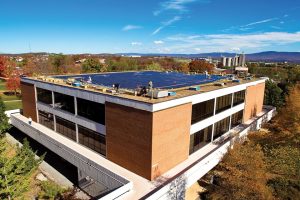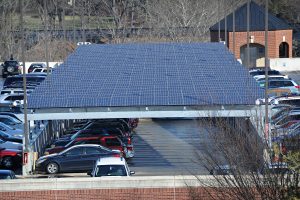Jun 14, 2016
Distributed Generation: Increases Private Investment and Creates Jobs in the Commonwealth
The solar industry continues as the fastest growing industry in the U.S. and distributed generation represents a vital part of that growth. “Distributed generation” refers to small-scale distributed solar photovoltaic (PV) systems, such as those found on residential and commercial rooftops, that produce energy where it is used.
Neighboring states have embraced the solar industry and as a result, are experiencing dramatic economic growth in jobs, private investment and tax revenue. Unfortunately, Virginia is missing out on these economic opportunities. The Commonwealth remains one of the most restrictive energy markets in the country, stifling the development of distributed generation and discouraging investment.
Solar projects developed by Secure Futures, along with its local community partners in Virginia, validate the economic potential of distributed generation to the state economy and Virginia consumers. Policymakers in Virginia should allow distributed generation to compete in Virginia’s restricted energy market.
Current Status of Solar Energy in Virginia
According to the Solar Energy Industry Association, Virginia ranks last in the Mid-Atlantic region and in the bottom one-third of the country in terms of installed solar capacity, solar jobs and solar investments.
| State | Installed Solar Capacity
(2015 U.S. Rank) |
Solar Jobs
(Total) |
2015 Solar Investments
($ Billions) |
| North Carolina | 3rd | 6,000 | $ 1.689 |
| Georgia | 11th | 3,200 | $ .311 |
| Maryland | 13th | 4,300 | $ .410 |
| Virginia | 32nd | 2,000 | $ .028 |
Benefits of Distributed Solar Generation
Solar projects come in a variety of sizes (kilowatts v. megawatts) ranging from large utility-scale to smaller-scale distributed generation commercial and residential projects. Utility-scale solar power plants require significant amounts of land, often located at greater distances from the customer.
As noted by the Brookings Institute, NREL and others, solar distributed generation offers many advantages:
- Creates jobs in the local community.
- Benefits the entire electric grid through reduced capital investment costs, avoided energy costs, and reduced environmental compliance costs.
- Benefits consumers by providing affordable energy with long-term price stability.
- Supports the U.S. supply chain using “Made in America” steel and panels.
- Minimizes or eliminates electricity losses on the transmission lines because energy is generated and dispatched over long distances.
- Reduces the need to build new and expensive power plants.
- Reduces the volatility of grid and increases overall grid resiliency to natural or man-made disasters, such as storms or cyber attacks.
Virginia’s Restrictions on the Development of Distributed Generation
Two investor-owned utilities – Dominion Resources Inc. and American Electric and Power Inc. – dominate the Virginia electricity market with their generation, distribution and transmission of electricity service.
The primary financial vehicle in the U.S. for developing distributed generation is through third-party Power Purchase Agreements (PPA). Twenty-three states in the U.S. allow for third-party ownership of solar projects. Virginia offers a highly restricted PPA program.
In 2013, the Virginia Legislature passed a bill creating the PPA Pilot Program.
Virginia’s PPA Pilot Program:
- Limits the Capacity of the solar project to a maximum of (1) Megawatt (AC –alternating current), and a minimum of 50 Kilowatts (AC). The total Pilot Program is capped at 50 Megawatts (AC). This eliminates large corporate customers and residential customers from utilizing PPAs to meet their economic and environmental goals, and forces arbitrary ceilings on industry.
- Limits the Market Area to the service territory of Dominion Virginia Power, eliminating the ability for customers located in Appalachian Power service territory as well as electric cooperative and municipal cooperative territories from utilizing cost saving measures such as PPAs.
Nationwide, states are taking advantage of the fastest growing industry in the U.S. by supporting policies that recognize the value of solar in expanding the economy, developing new employment opportunities and benefiting consumers. Secure Future’s experience in developing distributed generation projects in Virginia supports these findings.
Distributed Generation Projects in Virginia: Case Studies
Despite the barriers to entry and development of distributed generation in Virginia, Secure Futures has installed projects that are generating clean energy at competitive prices. Those projects demonstrate actual economic benefits that accrue to the local as well as the Virginia state economy. The three Secure Futures projects described in below total over 800 kW of distributed solar electricity generation capacity, an estimated $3,250,000 of investment, of which $2,256,000 was in local spending, and creating 28 jobs.
University of Richmond, Richmond, Virginia
Secure Futures in partnership with the University of Richmond recently completed the first solar installation under Virginia’s PPA Pilot Program with high efficiency SolarWorld solar panels made in Oregon. The University of Richmond solar PV system will generate an estimated 237,000 kilowatt-hours of electricity each year, roughly equivalent to the energy needed to power 22 homes.

- System size – 205 kW
- Project investment – $680,000
- Local spending – $455,000
- FTE jobs – 5
- CO2 Offsets – 364,000 lbs. Annually
Eastern Mennonite University (EMU) Harrisonburg, Virginia
The EMU solar project was the first commercial-scale project in Virginia history, and at the time it went live, was the largest PV system of any kind in Virginia. The system incorporates high-efficiency solar panels made in the United States by Sun Power, based in California.

- System size – 104 kW
- Project investment – $400,000
- Local spending – $270,000
- FTE jobs – 4
- CO2 Offsets – 340,800 lbs. Annually
Washington and Lee University (W&L) Lexington, Virginia
W&L leases a 444-kilowatt solar PV system at two locations on campus. Altogether, both solar arrays hold 1,556 solar panels, all made in the United States, and a steel canopy structure fabricated by a Virginia employee-owned steel company.

- System size – 444 kW
- Project investment – $2,100,000
- Local spending – $1,500,000
- FTE jobs – 20
- CO2 Offsets – 1.4 million lbs. annually
References:
Brookings Institute Research Paper, Rooftop solar: Net Metering Is A Net Benefit, May 23, 2016, http://www.brookings.edu/research/papers/2016/05/23-rooftop-solar-net-metering-muro-saha.
National Renewable Energy Laboratory, March 2015, Value of Solar: Program Design and Implementation Considerations, http://www.nrel.gov/docs/fy15osti/62361.pdf